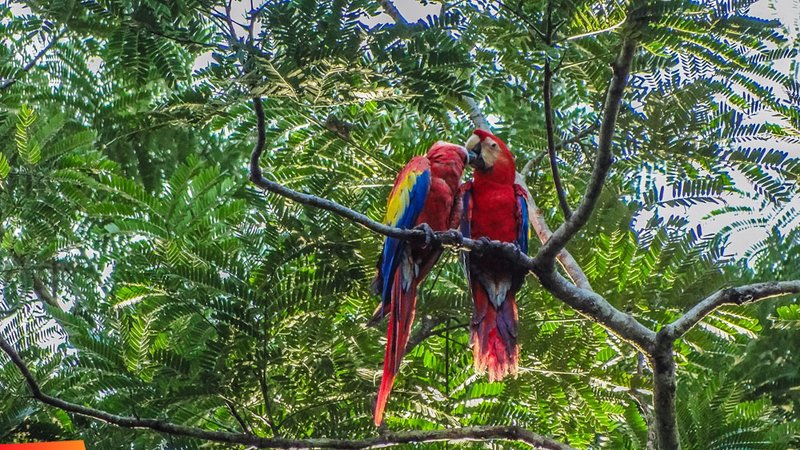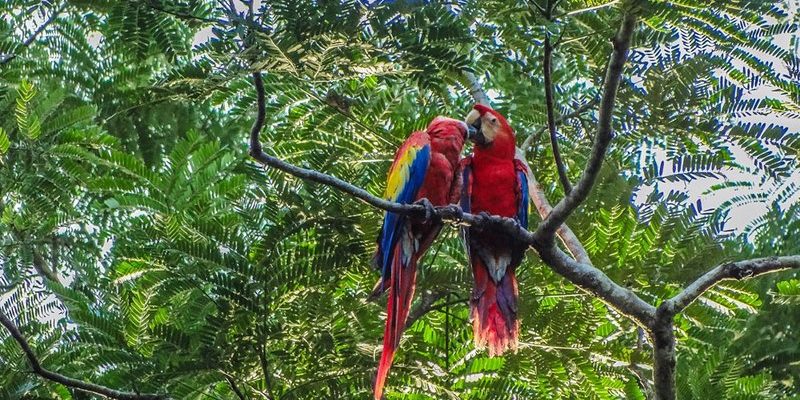
Scarlet macaws are native to Central and South America, but their habitat preferences can vary widely. Imagine walking through a lush, tropical rainforest, where the sound of their loud squawks fills the air. Or envision yourself standing near a serene riverbank, the sun glinting off the colorful feathers of these birds as they swoop down to drink. In this article, we’ll explore the various habitats and geographical ranges of the scarlet macaw, helping you understand where to catch a glimpse of these incredible birds in the wild.
South and Central America: The Heart of the Scarlet Macaw’s Range
Scarlet macaws thrive in the warm climates of Central and South America. Their primary habitats are found in tropical rainforests, dry forests, and near waterways. You’ll often find them in places like the Amazon Basin, which stretches across several countries, including Brazil, Colombia, and Peru. This vast region provides the lush greenery and abundant food supply that scarlet macaws love.
These birds are particularly fond of areas where palm trees grow, as these trees offer both food and nesting opportunities. Think of palm nuts as their favorite snacks that they munch on while perched high in the trees. In addition to palm trees, they feast on fruits, seeds, and flowers. If you’re looking to spot these birds, consider visiting regions with protected rainforests, like national parks or reserves, where they can thrive undisturbed.
The Amazon Rainforest: A Biodiversity Wonderland
The Amazon Rainforest is a prime spot for spotting scarlet macaws. This dense jungle is rich in biodiversity and offers a variety of habitats for these stunning birds. The vibrant colors of the macaws stand out against the lush green backdrop, making them a sight to behold.
In the Amazon, you’ll find them flying in flocks, often calling to each other with their loud, distinctive squawks. Visiting the Amazon can be a thrilling adventure, with opportunities for guided tours that help you navigate the complexities of its ecosystems. Think of it as a live nature documentary—full of excitement and wonder.
Coastal Areas: Where Land Meets Water
Scarlet macaws also enjoy coastal regions, especially where tropical forests meet rivers and beaches. The mix of ecosystems provides a diverse range of food sources and places to nest. Coastal areas in countries like Costa Rica and Honduras are particularly favorable for these birds.
If you’re ever exploring the Pacific coast of Costa Rica, keep an eye out for scarlet macaws flying above the mangroves or perched in the trees. These areas not only offer rich habitats for the birds but also stunning views for you. Imagine sipping your morning coffee with the sound of waves crashing in the background and the sight of colorful macaws soaring overhead—it’s a dream come true for many birdwatchers.
Utilizing Mangroves and Wetlands
Mangrove forests and wetlands are essential for scarlet macaws because they provide the necessary food and shelter. These birds often feed on the fruits of mangrove trees, which thrive in salty coastal waters. Spots like the Osa Peninsula in Costa Rica are renowned for their rich wildlife, including an abundance of scarlet macaws.
Wetlands not only serve as feeding grounds but also as critical breeding habitats. Migrating to these areas during specific seasons can increase your chances of seeing these captivating birds up close.
Urban Enclaves: Surprising Spots for Scarlet Macaws
You might be surprised to learn that scarlet macaws can occasionally be spotted in urban areas, especially near parks or botanical gardens that mimic their natural habitats. In cities like Panama City, you may find these birds flitting between trees in urban parks or even perched near buildings covered in greenery.
Urban areas offer unique opportunities for birdwatching enthusiasts who may not be able to travel deep into the rainforest. Sometimes, taking a stroll through a local park can yield unexpected sightings. If you’re lucky, you could witness a colorful macaw soaring across the skyline—it’s a beautiful reminder of nature’s resilience.
Conservation Areas and Zoos: Bringing the Jungle to You
Conservation areas and reputable zoos dedicated to preserving wildlife can offer up-close encounters with scarlet macaws. These places often house birds that have been rescued or bred in captivity, making them excellent alternatives for learning about these fascinating creatures without venturing into the wild.
Visiting these facilities can provide educational opportunities about conservation efforts and the importance of protecting these wonderful birds. You might even get a chance to feed, touch, or photograph them, enhancing your appreciation for their beauty and intelligence.
Best Times for Spotting Scarlet Macaws
Timing your adventure can significantly impact your chances of seeing scarlet macaws. Generally, the best time to spot them is during the dry seasons, when food sources are more abundant, and the birds are more active. This usually occurs between late November and early March in Central America.
During this period, scarlet macaws are often more visible as they search for food and establish nesting sites. Early mornings or late afternoons are typically the ideal times for viewing since these birds are more likely to be out and about. Imagine setting out for a hike at dawn, the sun illuminating the sky, as you hope to catch sight of these magnificent creatures greeting the day.
Migration Patterns: Understanding Seasonal Movements
While scarlet macaws are generally residents in their chosen habitats, some may exhibit migratory patterns based on the availability of food. Changes in weather and seasonal conditions can drive them to seek new areas. This can lead to fascinating opportunities to observe the birds in unexpected places—like a treasure hunt for nature lovers.
Understanding these patterns can enhance your birdwatching experience. If you plan to visit areas where they are known to migrate, do a little research ahead of time. This way, you can increase your chances of spotting them and learn more about their behaviors in different environments.
Protecting Scarlet Macaws: Why It Matters
While spotting scarlet macaws can be a thrilling experience, it’s crucial to remember that they face threats that put their populations at risk. Habitat loss, poaching, and illegal trade have significantly impacted their numbers in the wild. Supporting conservation efforts and responsible birdwatching practices are essential for ensuring these beautiful birds continue to thrive.
By visiting conservation areas or joining guided tours with ethical practices, you contribute to efforts aimed at preserving their habitats and educating others about these captivating creatures. You might be wondering how you can make a difference, and it starts with awareness and action.
How You Can Help
If you’re passionate about protecting scarlet macaws, consider supporting local conservation organizations or participating in birdwatching events that promote awareness. Even small actions, such as spreading the word or advocating against illegal wildlife trade, can make a big difference. Together, we can work towards a future where scarlet macaws continue to soar through the skies.
Final Thoughts on Spotting Scarlet Macaws
Whether you’re a seasoned birdwatcher or just curious about wildlife, spotting a scarlet macaw can be an unforgettable experience. From the heart of the Amazon rainforest to urban parks, these vibrant birds remind us of the beauty of nature. By understanding their habitats and the challenges they face, you can better appreciate these remarkable creatures and help ensure their survival for generations to come. So, if you’re planning a trip to Central or South America, don’t forget to keep your eyes peeled for the dazzling flashes of red, blue, and yellow—a scarlet macaw might just be waiting to brighten your day!

